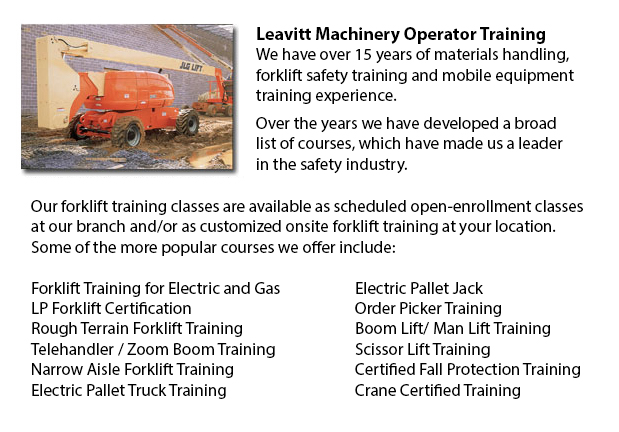
Aerial Platform Training Richmond Hill - Aerial forklifts might be used to accomplish certain different tasks done in hard to reach aerial places. A few of the duties associated with this style of lift include performing regular repair on buildings with elevated ceilings, repairing telephone and power cables, lifting heavy shelving units, and trimming tree branches. A ladder might also be used for some of the aforementioned projects, although aerial platform lifts provide more security and stability when properly used.
There are a couple of different models of aerial hoists existing, each being capable of performing slightly different tasks. Painters will often use a scissor lift platform, which can be utilized to reach the 2nd story of buildings. The scissor aerial jacks use criss-cross braces to stretch out and extend upwards. There is a table attached to the top of the braces that rises simultaneously as the criss-cross braces lift.
Cherry pickers and bucket lift trucks are a further type of the aerial hoist. Usually, they contain a bucket at the end of an extended arm and as the arm unfolds, the attached bucket lift rises. Lift trucks utilize a pronged arm that rises upwards as the handle is moved. Boom lift trucks have a hydraulic arm which extends outward and lifts the platform. Every one of these aerial lift trucks have need of special training to operate.
Training courses offered through Occupational Safety & Health Association, acknowledged also as OSHA, deal with safety steps, system operation, upkeep and inspection and machine cargo capacities. Successful completion of these education courses earns a special certified license. Only properly certified people who have OSHA operating licenses should operate aerial lift trucks. The Occupational Safety & Health Organization has established rules to uphold safety and prevent injury while utilizing aerial lifts. Common sense rules such as not utilizing this apparatus to give rides and making sure all tires on aerial lift trucks are braced so as to hinder machine tipping are mentioned within the guidelines.
Sadly, data reveal that in excess of 20 aerial hoist operators die each year while operating and nearly ten percent of those are commercial painters. The bulk of these accidents were caused by improper tie bracing, hence some of these may well have been prevented. Operators should make sure that all wheels are locked and braces as a critical security precaution to stop the device from toppling over.
Additional suggestions involve marking the encircling area of the machine in an observable manner to safeguard passers-by and to guarantee they do not approach too close to the operating machine. It is imperative to ensure that there are also 10 feet of clearance amid any utility cables and the aerial lift. Operators of this equipment are also highly recommended to always have on the appropriate safety harness while up in the air.
-
Scissor Lift Certification Richmond Hill
Scissor Lift Certification Richmond Hill - Scissor lift platforms are utilized at work sites in order to allow tradespeople - like for example welders, masons and iron workers - to reach their work. Operating a scissor lift platform is usually second... More -
Narrow Aisle Forklift / Order Picker Training / Electric Pallet Jack / Electric Pallet Truck Training in Richmond Hill
A pallet jack is a model of equipment specialized in the transporting of pallets of many dimensions and weights. They might be utilized as an appendage for lift trucks, cranes and other types of heavy machinery or be used on their own. Pallet jacks a... More -
Heavy Equipment Operator Certification Richmond Hill
Heavy Equipment Operator Certification Richmond Hill - The heavy equipment operator is a person who manipulates the controls and drives various kinds of big machinery. Heavy machinery is most frequently used on construction sites in order to deliver... More -
Loader Training Richmond Hill
Loader Training Richmond Hill - Why You Must Finish A Loader Training Course - Individuals wanting work in businesses that use lift trucks must undergo a Loader Training program prior to becoming a certified operator of a lift truck. There are lots o... More -
Manlift Training Richmond Hill
Manlift Training Richmond Hill - Various manlift training programs consist of the review and content of manlift devices. An important part of the course is the practicum where students show their knowledge and practical ability to safely operate a ma... More -
Fall Protection Training in Richmond Hill
There are many injuries at work associated to falling and a lot of fall-related deaths reported every year. Most of these instances could have been prevented with better training, better measures in place, and by correctly equipping personnel before... More -
Wheel Loader Training Richmond Hill
Wheel Loader Training Richmond Hill - Commonly, the various kinds of heavy equipment training are classed into 2 categories of machinery: those which have rubber tires and tracked vehicles. Tracked vehicles consist of items like cranes, bulldozers an... More -
Forklift Certification Schools Richmond Hill
Forklift Certification Schools Richmond Hill - Forklift Certification is mandatory in North America. Hence, forklift training programs are important both for companies and for people seeking jobs in industries as forklift operators. Forklift training... More

Forklift Training Richmond Hill
TOLL FREE: 1-888-254-6157
Richmond Hill, Ontario
forklifttrainingrichmondhill.com
Email Us
About Us


